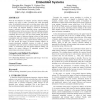Free Online Productivity Tools
i2Speak
i2Symbol
i2OCR
iTex2Img
iWeb2Print
iWeb2Shot
i2Type
iPdf2Split
iPdf2Merge
i2Bopomofo
i2Arabic
i2Style
i2Image
i2PDF
iLatex2Rtf
Sci2ools
SAC
2009
ACM
2009
ACM
Impact of function inlining on resource-constrained embedded systems
With the development of computer systems, function inlining schemes were used to reduce execution time while increasing codes. In embedded systems such as wireless sensor nodes, there are extreme limitations on memory space and battery power. This is the reason why function inlining is useful for maximizing memory utilization while minimizing energy consumption of embedded systems. In the previous works, basic inlining schemes were proposed, which were adapted to systems with code memory constraints. However, they were too coarse-grained, and did not evaluate the impact of function inlining in terms of both energy consumption and code memory utilization in actual systems. In this paper, we propose a fine-grained function inlining scheme. We also present the impact of function inlining schemes on resource-constrained embedded systems, in terms of energy consumption and code memory overhead. Based on experimental results, we demonstrate that fine-grained function inlining can improve th...
Related Content
| Added | 23 Jul 2010 |
| Updated | 23 Jul 2010 |
| Type | Conference |
| Year | 2009 |
| Where | SAC |
| Authors | Bongjae Kim, Sangho Yi, Yookun Cho, Jiman Hong |
Comments (0)

